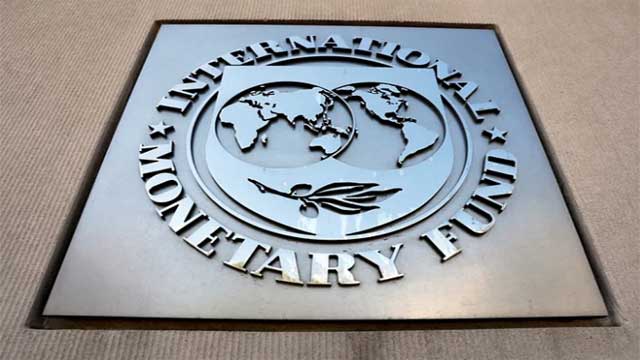The net foreign exchange reserves would have to be USD 24.46 billion in June, according to one of the main conditions set by the International Monetary Fund (IMF), ahead of approving a loan programme for Bangladesh.
As per Bangladesh Bank, the gross reserve was USD 31.20 billion in June.
According to the IMF calculation system Balance of Payments and International Investment Position (BPM6), the reserve was USD 24.75 billion.
Outside of this, there is another record of net reserves, which Bangladesh Bank didn't disclose.
Although people are not informed, Bangladesh Bank is informing IMF the net reserve regularly in accordance with their conditions.
Recently the IMF has been informed that the net reserve stands at a little over USD 20 billion. As a result, there are three types of information--the gross reserve, as per BPM6 reserve and net reserve.
Now the import costs of three months can be paid with the net reserve. The import costs in May was USD 6.46 billion. Bangladesh Bank has planned to reduce the sale of dollars as the reserve is decreasing. As a result, government imports may be hampered. Earlier, as dollars were not provided from the reserves, the power crisis was sparked off. Generally speaking, it is comfortable for the economy if there is a reserve to meet import expenditure for three months.
If net reserve falls short of the IMF’s requirements, the IMF loan instalment may be put on hold, former World Bank chief economist Zahid Hussain observed.
He told that the net reserve fell short in June and the IMF usually halts its loan instalment if their conditions were not fulfilled. However, there are ways to get an exemption and this requires a letter to be written to IMF detailing what effective measures have been taken to increase the reserve. Then if the lending agency agrees, they will release the instalment.
Zahid Hussain further said no effective measure was taken to increase the reserves. Bangladesh Bank halved the reserves by selling dollars daily. The government tried to solve the crisis by reducing imports, but this didn’t work. There is no alternative to increase the dollar supply, and for this, the ceiling of the dollar price must be lifted. It is not certain that such move will mitigate the crisis, but at least an attempt can be made, he added.
IMF’s loan and actual reserves
At the end of January this year, the global lender gave an approval to the proposal of USD 4.7 billion loan on condition of meeting some specific conditions in different sectors. Bangladesh got USD 476.27 million as the first installment of the loan in February. One of the main conditions was to have an actual forex reserve of USD 24.46 billion in June and raising it to USD 25.3 billion in September and USD 26.8 billion in December. The International Monetary Fund informed Bangladesh of the method that has to be used to calculate the actual forex reserve status. Bangladesh Bank has also started to inform IMF about the actual forex reserve status following the procedure.
Following the written methods provided by IMF, the reserves are USD4.5 billion less than the amount calculated using BPM6 (Balance of Payments and International Investment Position Manual). Of the amount, USD1.09 billion has to be deducted as dues of Asian Clearing Union (ACU), USD 1.25 billion to be deducted as the amount is saved in the foreign reserve clearing accounts of the banks and USD 2.04 billion is in the special drawing right (SDR) accounts. As a result, the actual reserve stands at $20.37 billion.
IMF’s method of calculation
One of the conditions IMF put forth to Bangladesh was to begin calculating reserves using BPM6 by last June with the view to enhance transparency in Bangladesh Bank and the quality of reporting. There were some other conditions. The amount used to form the export development fund (EDF), long term fund (LTF) and green transformation fund (GTF), money given to Biman Bangladesh Airlines through Sonali Bank for buying aircraft and the money spent for dredging Rabnabad channel of Payra port have to be deducted to calculate the amount of actual reserves.
Bangladesh Bank spokesperson Mesbahul Haque on Sunday said IMF has not only set a goal regarding forex reserves, there are many other issues also. Information of the amount of reserve has been published following the method they recommended. It has to be seen whether all the goals have been met. All the information will be found after a meeting with the IMF. IMF will be apprised then.
Dollar situation
The dollar crisis started due to commodity prices going up in the global market after Russia invaded Ukraine in April last year. The dollar crisis has eased somewhat following different steps including the sale of dollars from the reserve.
However, the reserve has plummeted from USD 48 billion to USD 24 billion in two years. Bangladesh Bank has sold USD 13.85 billion (1,385 crore) from reserves in the 2022-23 fiscal year. Previously in the 2021-22 fiscal year, it had sold USD 7.62 billion (763 crore) from the reserve.
Meanwhile, the dollar price has gone up from Tk 88 to 109 in the last one and a half years. For the food and commodity prices going up because of this, the inflation has soared to almost 10 per cent now. Bangladesh resorted to the IMF for dollars, only after the situation had taken such a turn.
The dollar price stands at Tk 109 for payment of import dues. But, some are paying Tk 112-113 also. In terms of remittance, the dollar price is fixed at Tk 108.50 and the price drops to Tk 107.50 when it comes to export income.
Businesspersons say that, as they failed to avail the required amount of dollars from the banks, many of them have shrunk their businesses and many importers have even closed down business completely.





